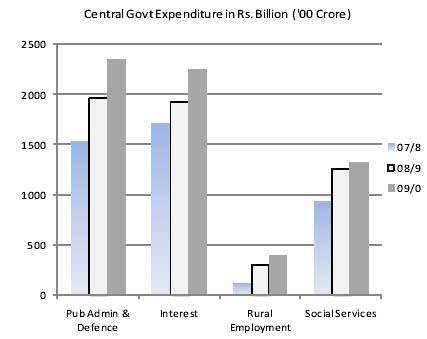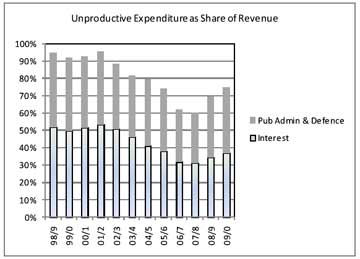
Archive 2009
|
July 16-31, 2009
Union Budget 2009-10: Pursuing the capitalist agenda while pretending to serve
During the first four years of the first Manmohan Singh government, 2004-08, corporate profits in our country grew more rapidly than ever before. The Tatas, Ambanis, Birlas and other monopoly houses more than doubled their wealth. The combined wealth of the 10 richest businessmen in India reached the astronomical level of Rs. 8.4 lakh crore (US$ 200 billion) by June 2008. Since the global crisis broke out, the capitalists have suffered some loss of wealth as the value of many stocks they own declined. The total wealth of the 10 richest fell from 8.4 to 7.2 lakh crore, between June 2008 and June 2009. The central government's response has been to extend further tax concessions to the capitalists and spend more on their behalf, in the name of 'fiscal stimulus', to restore the high rates of growth in profits that they enjoyed before the crisis. The total value of tax concessions given to the corporate sector and to highly paid senior executives rose from Rs. 285,000 crore in 2007/08 to 418,000 crore in 2008/09.
The bourgeois spokesmen talk as if the government's budget is what determines who will prosper and who will suffer in society. In reality, the distribution of ownership of the means of production – that is, who owns and controls how much of land, mines, factories and other means of social production – determines the distribution of income. What the budget does is to redistribute the income that has already been distributed. Typically, the budget of a bourgeois government is geared to distribute concessions and hand outs to capitalists, invest public money on their behalf, squeeze taxes out of the pockets of working people, and get the nation further indebted to domestic and foreign finance capital. Pranab Mukherjee's budget is not fundamentally different from this. Stimulating demand for various goods that the capitalists want to sell is the aim of various measures announced in the budget. With this aim, total expenditure of the central government was increased sharply through 3 packages of 'fiscal stimulus' in 2008/09 to reach Rs. 9 lakh crore, from 7 lakh crore in 2007/08. Total government spending is now being targeted to rise to over Rs. 10 lakh crore in 2009/10. The Finance Minister claims that job creation is the purpose of increased government spending. In reality, by the government’s own admission, at least ten lakh jobs were lost between October 2008 and March 2009. The real purpose of increased government spending is to help the capitalist owners of industry and services, by creating additional demand for their products. The bulk of increased government spending will be on the unproductive state apparatus and on paying interest on accumulated debt. The expenditure on police is targeted to be doubled in two years, to reach Rs 33,000 crore in 2009-10. The expenditure on defence forces proposed for this year is an astronomically high Rs 1.45 lakh crore, from less than Rs 95,000 crore in 2007-08. The Indian government is now one of the largest buyers of arms in the world. As against the expenditure of Rs 1.8 lakh crore on the oppressive apparatus of the state, and Rs. 2.3 lakh crore on interest payments, the provision for expenditure on all social services together is only Rs 102,000 crore. The allocation for the National Rural Employment Guarantee (NREG) program, the major flagship program introduced by the Manmohan Singh government in its first tenure, was raised to Rs. 39,000 crore in 2009/10. The original budget allocation for this program in 2008/09 was 16,000 crore; but during the year, it was raised to Rs. 30,000 crore as part of the 'fiscal stimulus'. Compared to this, the current year's budget represents an increase of 30%. However, the Finance Minister said in his speech that the increase was 144%. He was deliberately comparing with the original budget allocation last year, so as to exaggerate the aam aadmi look of his budget. The net additional borrowing by the central government is projected to be as large as Rs. 4 lakh crore during 2009/10. This is determined by the ‘fiscal deficit’ – the gap between revenue and total expenditure, which has to be financed by borrowing. This will raise the total outstanding debt of the central government to about Rs. 34 lakh crore by March 31, 2010 – roughly Rs. 29,000 per person in the country. Adding the debt of state governments will raise this close to Rs. 50,000 per person. The share of central government revenue consumed by interest payments is projected to rise to 37% in 2009/10, from 31% in 2007/08. Share prices fell immediately following the budget, reflecting the fact that many policy reforms that capitalists wanted the government to undertake, such as the opening up of insurance to foreign investment, were not announced in the budget speech. This is nothing but deceptive tactics on the part of the government, so as to present this Budget as being aimed at the aam aadmi, by highlighting and exaggerating the allocations to social programs, while postponing the announcement of more blatantly pro-capitalist and anti-people measures. Overall, it is a budget aimed at accelerating the growth of capitalist profits and wealth of the bourgeoisie, through increased government spending and tax concessions, and mounting burden of public debt on the backs of present and future generations. |


